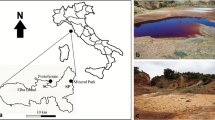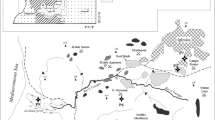Abstract
Plants evolved a number of coping mechanisms wherewith they overcome negative environmental influences. Secondary metabolites are essential in plants’ stress management toolbox. One of the crucial environmental problems is contamination of soil with toxic heavy metals by different human activities. Serpentine soils are naturally burdened with heavy metals, thus presenting a great model for studying heavy metal tolerance in plants and their mechanisms of adapting to metalliferous soils. Plantago lanceolata L. is a widespread species adapted to both different environmental factors and different soils. In order to analyze the physiological status of P. lanceolata populations from metalliferous and non-metalliferous soils, we collected specimens from metalliferous soils including serpentine outcrops of central Bosnia and area artificially contaminated with heavy metals as well as from non-metalliferous soil. Heavy metal content (Cd, Cr, Mn, Co, Cu, Ni, Pb, Zn, and Fe) was determined in both herb and soil in order to test metal availability and accumulation potential of the analyzed individuals. Contents of total phenolics, phenolic acids, flavonoids, chlorophylls a and b, and proline were determined using spectrophotometric methods. The highest content of total phenolics was observed in a sample from anthropogenic site while proline showed a higher concentration in plants from serpentine soils. Regardless of high concentrations of Ni, Zn, and Cr in soil, P. lanceolata showed remarkable tolerance to serpentine soils as no significant differences in biochemical and physiological parameters were found in plants from metalliferous and non-metalliferous sites. These results indicate the existence of adaptive mechanisms and potential use of P. lanceolata in the remediation of heavy metal–polluted soils.




Similar content being viewed by others
References
Arthur, E. L., Rice, P. J., Rice, P. J., Anderson, T. A., Baladi, S. M., Henderson, K. L. D., & Coats, J. R. (2005). Phytoremediation – an overview. Critical Reviews in Plant Sciences, 24, 109–122. https://doi.org/10.1080/07352680590952496.
ATSDR (2008). Draft toxicological profile for manganese. U.S. Department of Health and Human Services, Public Health Service. Agency for Toxic Substances and Disease Registry, USA.
Baker, A. J. M. (1981). Accumulators and excluders – strategies in the response of plants to heavy –metals. Journal of Plant Nutrition, 3(1–4), 643–654. https://doi.org/10.1080/01904168109362867.
Bhargava, A., Carmona, F. F., Bhargava, M., & Srivastava, S. (2012). Approaches for enhanced phytoextraction of heavy metals. Journal of Environmental Management, 105, 103–120. https://doi.org/10.1016/j.jenvman.2012.04.002.
Carillo, P., & Gibon, Y. (2011). PROTOCOL: extraction and determination of proline. Prometheus Wiki.
Chaves, M. M., Costa, J. M., & Saibo, N. J. M. (2011). Recent advances in photosynthesis under drought and salinity. In I. Turkan (Ed.), Advances in botanical research (Vol. 57, pp. 50–83). https://doi.org/10.1016/B978-0-12-387692-8.00003-5.
Cook, M. E. (1994). "Cadmium pigments: when should I use them?" Inorganic pigments. Environmental issues and technological opportunities. London: Industrial Inorganic Chemicals Group, Royal Society of Chemistry.
Da Silva, W. R., Da Silva, F. B. V., Araujo, P. R. M., & Do Nascimento, C. W. A. (2017). Assessing human health risks and strategies for phytoremediation in soils contaminated with As, Cd, Pb, and Zn by slag disposal. Ecotoxicology and Environmental Safety, 144, 522–530. https://doi.org/10.1016/j.ecoenv.2017.06.068.
Denneman, P. R. J., & Robberse, J. G. (1990). Contaminated soils “90”. In F. Arendt, M. Hinsenveld, & W. J. Vab Den Brink (Eds.), Ecotoxicological risk assessment as a base for development of soil quality criteria. Dordrecht: Kluwer.
Dixit, V., Pandey, V., & Shyam, R. (2002). Chromium ions inactivate electron transport and enhance superoxide generation in vivo in pea (Pisum sativum L. cv. Azad) root mitochondria. Plant, Cell & Environment, 25, 687–690. https://doi.org/10.1046/j.1365-3040.2002.00843.x.
Eddy, N. O., Odoemelam, S. A., & Mbaba, A. (2006). Elemental composition of soil in some dumpsites. Electronic Journal of Environmental, Agricultural and Food Chemistry, 5(3), 1349–1136. https://doi.org/10.4314/jasem.v18i1.1.10.
FAO/WHO (1976). List of maximum levels recommended for contaminants by the joint FAO/WHO codex Alimentarias Commission. 2nd series, CAC/FAL, 1976, 3: 1–8.
Hammer, Ø., Harper, D. A. T., & Ryan, P. D. (2001). PAST: palaeontological statistics software package for education and data analysis. Palaeontologia Electronica, 4(1), 9.
Hayat, S., Hayat, Q., Alyemeni, M. N., Wani, A. S., Pichtel, J., & Ahmad, A. (2012). Role of proline under changing environments. Plant Signaling and Behavior, 7(11), 1456–1466. https://doi.org/10.4161/psb.21949.
International Organization for Standardization. (1995). Soil quality – extraction of trace elements soluble in aqua regia. International Standard ISO 11466:1995. Geneve, Switzerland.
International Organization for Standardization. (1998). Soil quality – determination of cadmium, chromium, cobalt, copper, lead, manganese, nickel and zinc, flame and electrothermal AAS. International standard ISO 11047:1998. Geneve, Switzerland.
Jain, R., Srivastava, S., Madan, V. K., & Jain, R. (2000). Influence of chromium on growth and cell division of sugarcane. Indian Journal of Plant Physiology, 5, 228–231.
Jaleel, C. A., Jayakumar, K., Chang-Xing, Z., & Iqbal, M. (2009). Low concentration of cobalt increases growth, biochemical constituents, mineral status and yield in Zea Mays. Journal of Scientific Research, 1(1), 128–137. https://doi.org/10.3329/jsr.vlil.1226.
Jayakumar, K., & Jaleel, C. A. (2009). Uptake and accumulation of cobalt in plants: a study based on exogenous cobalt in soybean. Botany Research International, 2(4), 310–314.
Keilig, K., & Ludwig-Müller, J. (2009). Effect of flavonoids on heavy metal tolerance in Arabidopsis thaliana seedlings. Botanical Studies, 50, 311–318.
Koptsik, G. N. (2014). Problems and prospects concerning the phytoremediation of heavy metal polluted soils: a review. Eurasian Soil Science, 47(9), 923–939. https://doi.org/10.1134/S1064229314090075.
Korkina, L. G. (2007). Phenylpropanoids as naturally occurring antioxidants: from plant defence to human health. Cellular and Molecular Biology, 53, 15–25. https://doi.org/10.1170/T772.
Kováčik, J., & Klejdus, B. (2008). Dynamics of phenolic acids and lignin accumulation in metal-treated Matricaria chamomilla roots. Plant Cell Reports, 27, 605–615. https://doi.org/10.1007/s00299-007-0490-9.
Kulbat, K., & Leszczyńska, J. (2015). Antioxidants as a defensive shield in thyme (Thymus vulgaris L.) grown on the soil contaminated with heavy metals. Biotechnology and Food Science, 7(2), 109–117.
Lavid, N., Schwartz, A., Yarden, O., & Telor, E. (2001). The involvement of polyphenols and peroxidase activities in heavy metal accumulation by epidermal glands of waterlily (Nymphaeceaea). Planta, 212(3), 323–331. https://doi.org/10.1007/s004250000400.
Li, Y., Kui-Shan, W., Xiao, R., Ying-Xian, Z., Feng, W., & Qiang, W. (2018). Response of plant secondary metabolites to environmental factors. Molecules, 23(4), 762. https://doi.org/10.3390/molecules23040762.
Lichtenthaler, H. K. (1987). Chlorophylls and carotenoids: pigments of photosynthetic biomembranes. Methods in Enzymology, 148, 350–382. https://doi.org/10.1016/0076-6879(87)48036-1.
Lisjak, M., Spoljarević, M., Agić, D., & Andrić, L. (2009). Practicum – plant physiology. Osijek: Joseph George Strossmayer University of Osijek.
Luthria, D. L., Mukhopadhyay, S., & Krizek, D. T. (2006). Content of total phenolics and phenolic acids in tomato (Lycopersicon esculentum Mill.) fruits as influenced by cultivar and solar UV radiation. Journal of Food Composition and Analysis, 19(8), 771–777. https://doi.org/10.1016/j.jfca.2006.04.005.
Mahar, A., Wang, P., Ali, A., Awasthi, M. K., Lahori, A. H., Wang, Q., Li, R., & Zhang, Z. (2016). Challenges and opportunities in the phytoremediation of heavy metals contaminated soils: a review. Ecotoxicology and Environmental Safety, 126, 111–121. https://doi.org/10.1016/j.ecoenv.2015.12.023.
Malekia, M., Ghorbanpourb, M., & Kariman, K. (2017). Physiological and antioxidative responses of medicinal plants exposed to heavy metals stress. Plant Gene, 11, 247–254. https://doi.org/10.1016/j.plgene.2017.04.006.
Michalak, A. (2006). Phenolic compounds and their antioxidant activity in plants growing under heavy metal stress. Polish Journal of Environmental Studies, 15(4), 523–530.
Ministry of Housing, Spatial Planning and Environment. (1994). The Netherlands’ national environmental policy Plan 2, VROM 93561/d//4-94 1221/027, The Hague, The Netherlands.
Mukhopadhyay, M. J., & Sharma, A. (1991). Manganese in cell metabolism of higher plants. The Botanical Review, 57(2), 117–149. https://doi.org/10.1007/BF02858767.
Nadgorska-Socha, A., Ptasinski, B., & Kita, A. (2012). Heavy metal bioaccumulation and antioxidative responses in Cardaminopsis arenosa and Plantago lanceolata leaves from metalliferous and non-metalliferous sites: a field study. Ecotoxicology, 22, 1422–1434. https://doi.org/10.1007/s10646-013-1129-y.
Nikolić, N., Kojić, D., Pilipović, A., Pajević, S., Krstić, B., Borišev, M., & Orlović, S. (2008). Responses of hybrid poplar to cadmium stress: photosynthetic characteristics, cadmium and proline accumulation, and antioxidant enzyme activity. Acta Biologica Cracoviensia Series Botanica, 50(2), 95–103.
O’Dell, R. E., James, J. J., & Richards, H. (2006). Congeneric serpentine and nonserpentine shrubs differ more in leaf Ca:Mg than in tolerance of low N, low P, or heavy metals. Plant and Soil, 280, 49–64. https://doi.org/10.1007/s11104-005-3502-y.
Perez-Espinosa, A., Moreno-Caselles, J., Moral, R., Perez-Murcia, M. D., & Gomez, I. (2006). Effect of cobalt on chlorophyll and carotenoid contents in tomato plants. Journal of Plant Nutrition, 25(9), 1933–1940. https://doi.org/10.1081/PLN-120013285.
Rumball, W., Keogh, R. G., Lane, G. E., Miller, J. E., & Claydon, R. B. (1997). ‘Grasslands Lancelot’ plantain (Plantago lanceolata L.). New Zealand Journal of Agricultural Research, 40(3), 373–377. https://doi.org/10.1080/00288233.1997.9513258.
Samantaray, S., Rout, G. R., & Das, P. (2001). Induction, selection and characterization of Cr and Ni-tolerant cell lines of Echinochloa colona (L) in vitro. Journal of Plant Physiology, 158, 1281–1290. https://doi.org/10.1078/0176-1617-00533.
Shah, F. U. R., Ahmad, N., Masood, K. R., & Peralta-Videa, J. R. (2010). Heavy metal toxicity in plants. In M. Ashraf, M. Ozturk, & M. S. A. Ahmad (Eds.), Plant adaptation and phytoremediation. Dordrecht: Springer.
Shakya, K., Chettri, M. K., & Sawidis, T. (2008). Impact of heavy metals (copper, zinc, and lead) on the chlorophyll content of some mosses. Archives of Environmental Contamination and Toxicology, 54, 412–421. https://doi.org/10.1007/s00244-007-9060-y.
Sharma, S. S., & Dietz, K. J. (2006). The significance of amino acids and amino acid-derived molecules in plant responses and adaptation to heavy metal stress. Journal of Experimental Botany, 57, 711–726. https://doi.org/10.1093/jxb/erj073.
Singh, O. V., Labana, S., Pandey, G., Budhiraja, R., & Jain, R. K. (2003). Phytoremediation: an overview of metallic ion decontamination from soil. Applied Microbiology and Biotechnology, 61, 405–412. https://doi.org/10.1007/s00253-003-1244-4.
Stanković, M. S. (2011). Total phenolic content, flavonoid concentration and antioxidant activity of Marrubium peregrinum L. extracts. Kragujevac Journal of Science, 33, 63–72.
Stewart, A. V. (1996). Plantain (Plantago lanceolata) – a potential pasture species. Proceedings of the New Zealand Grassland Association, 58, 77–86.
Suckling, D. M., Burnip, G. M., Walker, J. T. S., Shaw, P. W., McLaren, G. F., Howard, C. R., Lo, P., White, V., & Fraser, J. (1998). Abundance of leafrollers and their parasitoids on selected host plants in New Zealand. New Zealand Journal of Crop and Horticultural, 26(3), 193–203. https://doi.org/10.1080/01140671.1998.9514055.
Sun, R. L., Zhou, Q. Z., Sun, F. H., & Jin, C. X. (2007). Antioxidative defense and proline/phytochelatin accumulationin a newly discovered Cd-hyperaccumulator, Solanum nigrum L. Environmental and Experimental Botany, 60, 468–476. https://doi.org/10.1016/j.envexpbot.2007.01.004.
Szaufer-Hajdrych, M., & Goślińska, O. (2004). The quantitative determination of phenolic acids and antimicrobial activity of Symphoricarpus albus (L.) Blake. Acta Poloniae Pharmaceutica, 61(1), 69–74.
Tashakor, M., Yaacob, W. Z. W., & Mohamad, H. (2011). Speciation and availability of Cr, Ni and Co in serpentine soils of Ranau, Sabah. American Journal of Geosciences, 2(1), 4–9.
Ullah, R., Hadi, F., Ahmad, S., Jan, A. U., & Rongliang, Q. (2019). Phytoremediation of lead and chromium contaminated soil improves with the endogenous phenolics and proline production in Parthenium, Cannabis, Euphorbia, and Rumex species. Water Air and Soil Pollution, 230, 40. https://doi.org/10.1007/s11270-019-4089-x.
Vangronsveld, J., Herzig, R., Weyens, N., Boulet, J., Adriaensen, K., Ruttens, A., Thewys, T., Vassilev, A., Meers, E., Nehnevajova, E., Van der Lelie, D., & Mench, M. (2009). Phytoremediation of contaminated soils and groundwater: lessons from the field. Environmental Science and Pollution Research International, 16(7), 765–794. https://doi.org/10.1007/s11356-009-0213-6.
Verbruggen, N., Hermans, C., & Schat, H. (2009). Molecular mechanisms of metal hyperaccumulation in plants. New Phytologist, 181(4), 759–776. https://doi.org/10.1111/j.1469-8137.2008.02748.x.
Viehweger, K. (2014). How plants cope with heavy metals. Botanical Studies, 55, 35. https://doi.org/10.1186/1999-3110-55-35.
Weber, E. (2003). Invasive plant species of the world: a reference guide to environmental weeds. Wallingford: CAB International.
Wu, W., Wu, P., Yang, F., Sun, D. L., Zhang, D. X., & Zhou, Y. K. (2018). Assessment of heavy metal pollution and human health risks in urban soils around an electronics manufacturing facility. Science of the Total Environment, 630, 53–61. https://doi.org/10.1016/j.scitotenv.2018.02.183.
Author information
Authors and Affiliations
Corresponding author
Additional information
Publisher’s Note
Springer Nature remains neutral with regard to jurisdictional claims in published maps and institutional affiliations.
Rights and permissions
About this article
Cite this article
Ahatović, A., Čakar, J., Subašić, M. et al. Plantago lanceolata L. from Serpentine Soils in Central Bosnia Tolerates High Levels of Heavy Metals in Soil. Water Air Soil Pollut 231, 169 (2020). https://doi.org/10.1007/s11270-020-04561-7
Received:
Accepted:
Published:
DOI: https://doi.org/10.1007/s11270-020-04561-7




